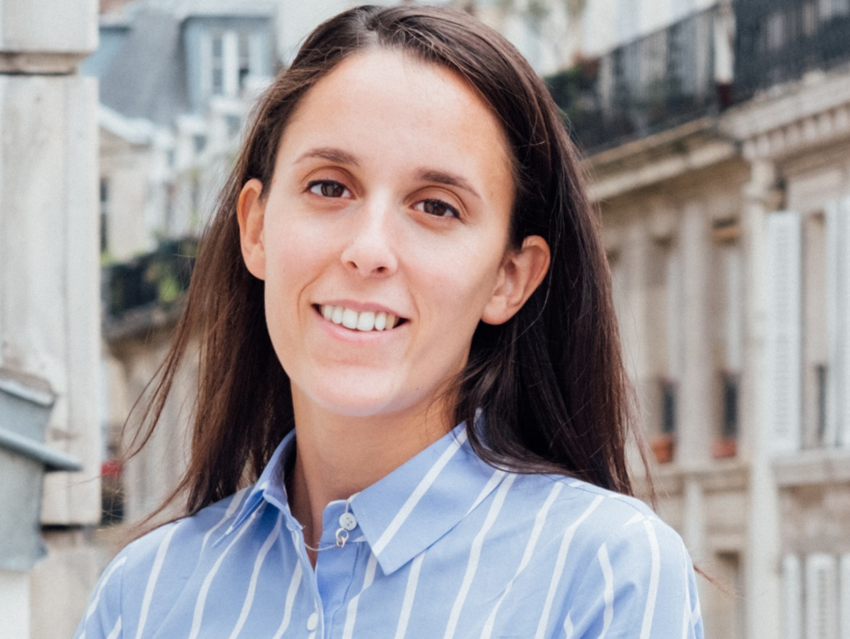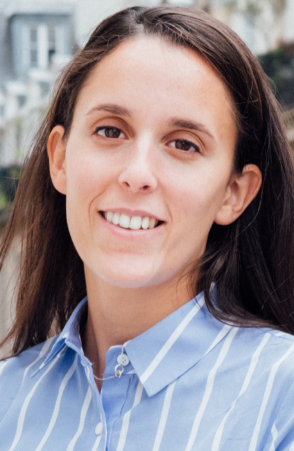Dr. Marion Paolini just finished her postdoc in one of the most well-known biotechnology labs. Since November 2017, she has been a Postdoctoral Associate at the laboratory of Professor Robert Langer at the Koch Institute for Integrative Cancer Research, Massachusetts Institute of Technology (MIT), Cambridge, MA, USA.
Here she speaks to Dr. Vera Koester, ChemViews Magazine, about her motivation to generate innovations for patients, the importance of mentoring and mutidisciplinary research teams, her experience in the Langer lab, as well as women in STEM (Science, Technology, Engineering, and Mathematics).
When did your interest in the biomedical field begin?
During my senior year of undergraduate studies at the University of Chicago, I decided to try working in a life sciences research laboratory, mostly out of curiosity. My major was in physics so I thought biophysics labs could be a perfect entryway into the biomedical field.
I knocked at the door of Professor Margaret Gardel, Director of the Material Research Science and Engineering Center, at the James Franck Institute & Institute for Biophysical Dynamics. She kindly offered me a research job although I had no lab experience. It was a great opportunity, I loved the lab work, the scientific methods. She was very encouraging by never saying no to my ideas but rather asked questions to point me in the right direction. She has been my first great mentor, encouraging me to pursue a scientific career.
What has been your biggest motivation?
My strongest motivation has always been to generate innovations that can help patients. Helping patients could be either by finding a cure for a disease, or a solution to diagnose faster and improve their outcome, or more generally modalities that can improve their quality of life. In that regard, I have always tried to work in biomedical engineering laboratories or companies, or at least in places prioritizing a very translational approach.
You did your postdoc with Professor Langer. How hard was it to get this position?
I did my Ph.D. thesis in the field of oncology and drug delivery. Professor Langer is a prominent scientist in this field, and I couldn’t imagine that I would have the opportunity to work with him for my postdoc at the time. I had read articles about his career and the way he manages his lab. I was particularly attracted by the multidisciplinary approach of his lab, the entrepreneurial spirit, and by the very positive work environment, he seemed to create. I had read that he was looking for not only excellent scientists but also kind individuals.
The lab I was working with for my Ph.D. thesis started a collaboration with Professor Langer. This is how I got the opportunity to interview for the postdoctoral position. Several hundreds of individuals apply every year for a postdoctoral position in the Langer lab. I was extremely lucky, not only to join the lab but also to work directly under the supervision of Professor Langer.
What are advantages of working for such a well-known scientist?
The reputation of the lab is extremely helpful to start collaborations. Professor Langer built such an impressive network around the lab, including alumni or friends of the lab, that it opened many doors for our projects and us personally.
For one of my research projects, for example, I wanted to ask oncologists in the Boston area on their opinion about the possibility to translate a technology we were developing into clinical use. Most oncologists happily met with me and brainstormed on our project. We even wrote a grant proposal with one of them.
Are there also disadvantages?
Some people may fear that they will get lost in such a big lab but, on the contrary, the environment is extremely reassuring and supportive. Professor Langer is surrounded with a great administrative team. Without micromanaging us, he is always available for us. He always answers every email in an unbelievably short amount of time! He is a well-known scientist but also a fantastic mentor and manager.
One of Professor Langer’s approaches is to facilitate multidisciplinary collaboration. How did you experience this and what makes this special?
One of the reasons I wanted to join the lab is the multidisciplinary environment. When I joined the lab, we were two postdocs working directly with Professor Langer, a chemist and myself, a biologist. We started working on several projects together because we were complementary. After two years, we were mentoring students together and created our own “subgroup”. I also collaborated with a pharmacist in the Langer lab and one of our students was a mechanical engineer. The different backgrounds of everyone help in coming up with innovative ideas. Everyone looks at the problem from a different perspective. This provides more of an opportunity to think about all problems right from the beginning and to think really of a product and not just a great idea in one discipline, for example, biology.
I believe what makes the multidisciplinary collaborations special at the Langer lab is the freedom and support we have to start projects together or with outside collaborators.
What is different from other laboratories? What can, for example, European universities learn from the extremely entrepreneur-friendly MIT concepts?
I think what makes the Langer lab special is a combination of factors. I can mention a few but I don’t think that they are the ingredients for a precise, reproducible recipe.
What makes the Langer lab special is first Professor Langer himself. His kindness and willingness to make us succeed in the lab and our future careers are fundamental.
Then, of course, the MIT environment is very important. Scientifically we are supported by excellent core laboratories. We are located in the Boston area, a perfect environment to find expertise in life sciences. MIT also provides strong communication and intellectual property services. Once a project is mature enough, a lot of communication material is published and the targeted audience is very wide, which may be different from some European universities. Then, once the intellectual property is secured, MIT encourages the inventors to develop their technologies, with attractive conditions. The Langer lab, in particular, has an impressive record of successful ventures. So investors are often willing to finance startups coming from this lab.
Finally, the approach of the lab helps in creating translatable technologies: The lab has great collaborations with industry and a strong focus on generating impactful and useful innovations.
You spoke several times about mentoring. Why is this of interest to you?
I am interested in mentoring because role models and mentors I had the chance to meet or work with are the reason why I chose a scientific career. At the very beginning of my scientific career, I had the chance to be supported by Professor Margaret Gardel, University of Chicago, and Professor Henry Hess, Columbia University. Both still help me and advise me. And very very recently by Professor Langer, of course. I learned a lot scientifically but also about their mentoring and managing styles.
How do you suggest finding a mentor? And what makes a good mentor in your opinion?
I believe a good mentor is someone kind, who favors the interest of their mentees. To find a mentor, I believe a good way to start may be to interact with alumni from your school or university. What worked for me was to ask a scientist working on topics of interest to me for a short discussion and then see if a connection evolves.
I like mentoring or advising female students in particular, because only 12 % of my class at École Polytechnique, the University where I studied, were female students. Beyond direct mentoring, I try to encourage young girls to consider a scientific direction. I participate in outreach events at the Koch Institute for Integrative Cancer Research, the Institute at MIT to which the Langer lab belongs. For the past ten years, I have also been sponsoring the studies of a young Cambodian girl who wants to become a medical doctor.
More directly, following Professor Langer’s advice, we recruited a talented master’s thesis student, whom I have been mentoring for five months. It is a pleasure to teach and advise motivated and talented people. I believe I may have learned more from this experience than her!
Do you think there are still differences between men and women in chemistry?
Of course, there are still differences between men and women in chemistry; facts are indisputable. For instance, according to the Open Chemistry Collaborative in Diversity Equity, in the US, in the 2016–17 academic year, an average of 20 % of the roughly 1,500 chemistry faculty were women. Reaching gender equality is a very delicate topic in my opinion.
I don’t believe women should be favored simply because of their gender in order to reach gender equality faster. This may create other frustrations. I have been criticized by men who were convinced I got certain diplomas or jobs mostly because I was a woman. I am convinced that the way to get gender equality in chemistry and science, in general, is to encourage girls to pursue a scientific education and to support young women at the beginning of their career, without denying opportunities to men.
And you are supporting this by activities you just described.
What would you like to be doing ten years from now?
I hope in ten years from now I will be bringing life-changing innovations to patients by participating in the research or development process of projects. I will certainly switch to an industry position soon to bring such innovations faster to patients. I also hope I will keep mentoring students and young professionals.
And what do you do in your spare time?
I like to run to decompress. I cook and bake: Recipes are like protocols and I’m interested in the ingredients’ chemistry and their effects on our organism.
Thank you for the interview and all the best for your future.
Marion Paolini studied engineering at the École Polytechnique, Paris, France and gained her Ph.D. in oncology and cancer biology from the Université Paris-Saclay, France, in cooperation with Nanobiotix, Paris, France, in 2017. During her studies, she worked as a research assistant at the University of Chicago, IL, USA, Columbia University, New York, NY, USA, and Lawrence Berkeley National Laboratory, CA, USA.
Since 2017, she has been a postdoctoral associate at the laboratory of Professor Robert Langer, Koch Institute for Integrative Cancer Research, Massachusetts Institute of Technology (MIT), Cambridge, MA, USA.
Selected Publications
- Marion Paolini, Owen Fenton, Chandrabali Bhattacharya, Jason Andresen, Robert Langer, Polymers for extended-release administration, Biomed. Microdevices 2019. https://doi.org/10.1007/s10544-019-0386-9
- Owen Fenton, Marion Paolini, Jason Andresen, Florence Müller, Robert Langer, Outlooks on Three-Dimensional Printing for Ocular Biomaterials Research, J. Ocul. Pharmacol. Ther. 2019. https://doi.org/10.1089/jop.2018.0142
- Owen Fenton, Jason Andresen, Marion Paolini, Robert Langer, β-Aminoacrylate Synthetic Hydrogels: Easily Accessible and Operationally Simple Biomaterials Networks, Angew. Chem. Int. Ed. 2018. https://doi.org/10.1002/anie.201808452
- Marion Paolini, Laurence Poul, Celine Berjaud, Matthieu Germain, Audrey Darmon, Maxime Bergère, Agnes Pottier, Laurent Levy, Eric Vibert, Nano-sized cytochrome P450 3A4 inhibitors to block hepatic metabolism of docetaxel, Int. J. Nanomedicine 2017. https://doi.org/10.2147/IJN.S141145
- Marion Paolini, Laurence Poul, Audrey Darmon, Matthieu Germain, Agnes Pottier, Laurent Levy, Eric Vibert, A new opportunity for nanomedicines: Micellar cytochrome P450 inhibitors to improve drug efficacy in a cancer therapy model, Nanomedicine Nanotechnology, Biol. Med. 2017. https://doi.org/10.1016/j.nano.2017.03.006



